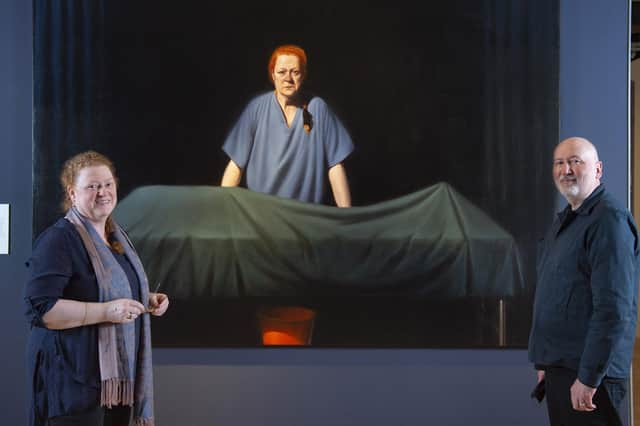Ken Currie’s portrait of Professor Sue Black in the Scottish National Portrait Gallery will be stopping viewers in their tracks for years to come – Laura Waddell


On public display for the first time as part of the Scottish National Portrait Gallery’s Modern Portrait exhibition, Unknown Man is every bit as haunting as Currie’s best-known painting Three Oncologists.
In that work, doctors – Professor RJ Steele, Professor Sir Alfred Cuschieri and Professor Sir David P Lane from Ninewells Hospital and Medical School in Dundee – look over their shoulders to confront the viewer, their forms luminescent and blurring at the edges into a soot-black backdrop, too dark to see what might lay ahead. Many gallery goers over the years will have felt a shiver down the spine standing before Currie’s rendering of eerie, mysterious mortality.
Advertisement
Hide AdAdvertisement
Hide AdThis clever title of this painting, Unknown Man, turns a common gallery phrasing referring to an unrecognised artist’s model into a nod to Professor Dame Sue Black’s formidable work.
Now President of the Royal Anthropological Institute, previously with the University of Dundee’s Centre for Anatomy and Human Identification, she visited countries struck by disasters and mass fatalities such as Iraq and Kosovo where she applied specialist forensic knowledge to restore identity to mortal remains. It is the most serious of work; the scenes she must have witnessed difficult to imagine.
In Unknown Man, Black is positioned centre and dressed in doctor’s scrubs, standing above a sheeted body on a gurney, and the viewer cannot avoid locking eyes with her red-rimmed stare.
Amidst the sombre pallet are two pops of colour. Matching the doctor’s striking orange-red hair is a bucket underneath the table – but to catch what? It’s more disconcerting not to know.
As with Three Oncologists, we don’t need to see a body to sense the bodily horror in the scene. Death, and what will become of us all one day, is the great unknown.
It’s difficult, now, not to view everything in relation to Covid. This painting was completed in 2019, before the pandemic had claimed thousands of lives across Britain.
How we will publicly immortalise this tragedy is still uncertain. While many have experienced loss in a personal sense, the bigger picture of Covid and loss can be difficult to grasp.
At the beginning, I refreshed Scottish government statistics as they ticked into double figures, then triple, before becoming numbed to the scale of it all.
Advertisement
Hide AdAdvertisement
Hide AdKen Currie’s portrait of Sue Black is a reminder that some in our society cannot look away, and in fact have dedicated their lives to doing this kind of essential death work, and we see something of the toll that must take in her facial expression. This is a powerful portrait of an extraordinary Scottish woman.
Walking around the rest of the exhibition, enjoying crowd-pleasers such as John Byrne’s angular Tilda Swinton and a gregarious Billy Connolly, I glazed over other pleasant but forgettable portraits of accomplished historical figures.
Ken Currie’s work is not easily forgotten. I feel sure that in 100 years’ time, the way he has captured something of the essence of Black’s work and the dual pain and dignity within it will still be stopping viewers in their tracks.
A message from the Editor:
Thank you for reading this article. We're more reliant on your support than ever as the shift in consumer habits brought about by coronavirus impacts our advertisers.
If you haven't already, please consider supporting our trusted, fact-checked journalism by taking out a digital subscription.
Comments
Want to join the conversation? Please or to comment on this article.
